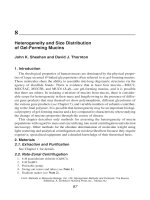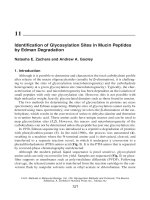Glycoprotein methods protocols - biotechnology 048-9-129-141.pdf
Bạn đang xem bản rút gọn của tài liệu. Xem và tải ngay bản đầy đủ của tài liệu tại đây (146.86 KB, 13 trang )
Synthetic Peptides for Antimucin Antibodies 129
129
From:
Methods in Molecular Biology, Vol. 125: Glycoprotein Methods and Protocols: The Mucins
Edited by: A. Corfield © Humana Press Inc., Totowa, NJ
12
Synthetic Peptides for the Analysis and Preparation
of Antimucin Antibodies
Andrea Murray, Deirdre A. O’Sullivan, and Michael R. Price
1. Introduction
Since the mid-1980s, the family of high molecular weight glycoproteins known as
mucins have evoked considerable interest among those in the field of cancer research.
Mucins, which are constituents of mucus, have a lubricating and protective function in
normal epithelial tissue (1). However, expression of mucin by the cancer cell is often
highly disorganized and upregulated, sometimes to the extent that mucin can be
detected in the circulation of the cancer patient. These changes in expression of mucin
observed in neoplasia have led to the exploitation of some members of the mucin
family as circulating tumor markers (2,3) or targets for diagnostic imaging (4–6) and
therapy of cancer.
The first mucin to have its primary amino acid sequence determined, MUC1, is also
the most extensively studied. This molecule is highly immunogenic, and a consider-
able number of anti-MUC1 monoclonal antibodies (mAbs) and fragments have been
produced by various methods. Some of these have found applications for radio-
immunoscintigraphy and targeted therapy of cancer, and others have been used to
detect circulating MUC1. Although such studies have yielded promising results, their
present application is somewhat restricted. In this age of genetic and protein engineer-
ing, we have, at our disposal, the technology to design antibodies with ideal character-
istics of size, affinity, and specificity for any desired application. However, before
considering such ambitions, we must first gain an understanding of the molecular
interactions between epitope and paratope when an antibody binds to its antigen. It is
essential that key residues involved in the interaction are identified so that a model of
how the interaction takes place on a three-dimensional level can be constructed. This
identification will enhance our ability to design antibodies with the correct character-
istics for our chosen application.
130 Murray et al.
1.1. Immunoassays
Both enzyme-linked immunosorbant assays (ELISAs) and radioimmunoassays have
been used in various formats to test antibody binding to synthetic peptides. The indi-
rect ELISA has the advantages of being easy to perform, having no requirement for
radioactive tracers, and producing results that are simple to interpret. The disadvan-
tage of the indirect ELISA is that the procedure requires that the antigen, in this case a
synthetic peptide, be immobilized on to the surface of a microtiter plate well. Classi-
cally this would be achieved by dispensing a solution of antigen into the wells of a
microtiter plate to allow adsorption, leaving the plate coated with antigen. However,
short synthetic peptides adsorbed on to plates in this way provide unpredictable and
inconsistent results. This problem may be owing to the fact that the orientation of the
peptide on the plate cannot be controlled or simply that short peptides do not adhere
well to polystyrene plates. Several methods of peptide modification have been utilized
to overcome these problems. One such procedure involves preparing branched-chain
polypeptides in which MUC1 immunodominant peptides ware conjugated to a polyl-
ysine backbone (7). These polylysine conjugates provide very potent MUC1-related
antigens for the interrogation of antibody specificity; however, the methodology for
their preparation is beyond the scope of this chapter. By far the most widely used
method for modifying short peptides so that they can be used as antigens in indirect
ELISA procedures is to conjugate the peptides to a large carrier protein such as bovine
serum albumin (BSA) (see Subheading 3.1. and Notes 1–3).
1.2. Tethered Peptide Libraries for Exploring Antibody Specificity
The peptide synthesis techniques developed by Geysen and colleagues (8) repre-
sent a significant development in the study of epitopes defined by antibodies reactive
with antigens of known primary structure. Unlike most other methods of simultaneous
peptide synthesis, this technique allows the concurrent synthesis of hundreds to thou-
sands of peptides so that libraries can be produced and simultaneously used as targets
for antibody binding. The peptides are synthesized on derivatized polyethylene or
polypropylene gears that are held on stems (Fig. 1) arranged in a microtitre plate for-
mat so that a simple ELISA procedure can be used to measure antibody binding. Pep-
tides are tethered via the carboxyl terminus.
Several different strategies have been described for peptide sequence design that
all provide different information on epitope structure and the fine specificity of an
antibody-peptide interaction. The Pepscan approach has been the most widely used
and involves the synthesis of a set of overlapping peptides that span the length of the
antigenic sequence (Subheading 3.2.). In a short peptide sequence, such as that of the
MUC1 variable number of tandem repeat (VNTR), each peptide may overlap the next
by all but one amino acid, giving rise to a set of 21 heptapeptides that spans the VNTR
sequence (Fig. 2). For larger proteins, it is more appropriate to produce longer
sequences that overlap each other by less residues, thereby spanning the length of the
antigenic sequence with a feasible number of peptides (see Note 4). In the Pepscan
approach, peptides are assayed for antibody-binding capacity by ELISA (Subheading
3.3.), and residues that are common to all the antibody-binding pins represent the mini-
Synthetic Peptides for Antimucin Antibodies 131
Fig. 1. The Multipin Peptide Synthesis System contains detachable polyethylene gears that
fit on to the end of stems. The stems are held in a block in an 8 x 12 microtiter plate format. The
surface of the gear is derivatized to give a solvent-compatible polymer matrix on which the
peptides are coupled during synthesis. The matrix also provides a two amino acid spacer group.
Fig. 2. Schematic representation of the overlapping peptides corresponding to the MUC1
VNTR sequence synthesized according to the Pepscan approach to epitope mapping. Antibod-
ies are allowed to react with each peptide, and those containing the epitope or minimum bind-
ing unit produce positive results. In this example, the epitope can be deduced as consisting of
the amino acids that are common to all positive pins (7–10). Hence, the epitope is PDTR.
132 Murray et al.
mum binding unit or epitope for that antibody (Fig. 2). Having identified the epitope
defined by an antibody using Pepscan, it may be useful to prepare a number of analogs
of that sequence in order to investigate the role of individual amino acids in the epitope
and to identify critical contact residues. Such peptide design stategies include
ommission analysis, alanine substitution and replacement net (RNET) analysis (see
Notes 5–9).
Libraries of peptides on pins can be obtained that comprise 400 different dipeptides
prepared with all possible combinations of the 20 natural amino acids. This approach
provides qualitative information on antibody specificity and permits identification of
significant features of an epitope that may contribute to antibody recognition and bind-
ing (see Notes 10 and 11).
1.3. Purification of Antibodies Using Peptide Affinity Chromatography
The identification of a linear peptide epitope within a protein sequence facilitates
the design of peptide affinity matrices that can be used to purify antibodies from bio-
logical feedstocks. Such an epitope affinity matrix has been produced by covalently
linking a synthetic peptide corresponding to the MUC1-immunodominant domain to
cyanogen bromide-activated Sepharose (Pharmacia, Uppsala, Sweden) (9). The
resulting matrix was remarkably efficient for the purification of a range of anti-MUC1
mAbs from biological feedstocks containing high levels of contaminating proteins
such as ascitic fluid and hybridoma supernatant (see Note 12).
Epitope affinity chromatography matrices have an advantage over other affinity
adsorbents in that the antibody is bound to the matrix specifically via the paratope.
Thus, eluted antibody is fully immunoreactive and of only the desired specificity.
Sepharose-peptide conjugates are simple to prepare and affinity chromatography is
more robust than other conventional chromatographic techniques in terms of column
packing and operation (see Subheading 3.4., Notes 13–15, and Fig. 3).
1.4. General Comments
The techniques described for the analysis of antimucin antibodies using synthetic
peptides can provide a great deal of information on epitope topography and structure.
The identification of critical binding residues within an epitope can provide clues to
the forces and residues involved in the antibody-antigen interaction. However, bear in
mind that the use of linear synthetic peptides can only provide a one-dimensional
solution to what is essentially a three-dimensional problem. Further structural studies
such as X-ray crystallography, nuclear magnetic resonance spectroscopy, and compu-
tational molecular modeling are essential if the knowledge gained is to be confirmed
and translated into a useful model on which to base antibody design strategies.
The structural information provided by studies such as those previously described
may be of use in peptide vaccine design. However, the analyses performed so far have
been mainly concerned with the interaction of murine antibodies, and it may be naive
to assume that the human immune system will process mucin-related antigens in the
same way. Preliminary epitope-mapping studies on human serum would suggest that
the immune response to MUC1 may differ considerably from that observed in the
mouse (10).
Synthetic Peptides for Antimucin Antibodies 133
Finally, it may be owing to the very nature of the mucins that such a wealth of informa-
tion has been provided by the techniques described. The VNTR provides a convenient
short sequence on which to base peptide synthesis strategies. In addition, most murine
antimucin antibodies analyzed to date have been shown to define short linear determi-
nants. It is unlikely that all other proteins and antibodies will be so accommodating.
Fig. 3. Schematic representation of the apparatus and reagents needed for the purification of
antibodies by peptide epitope affinity chromatography.









